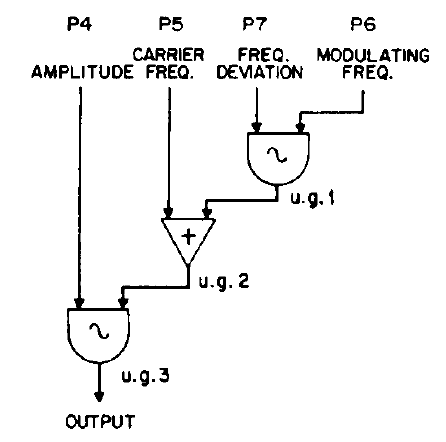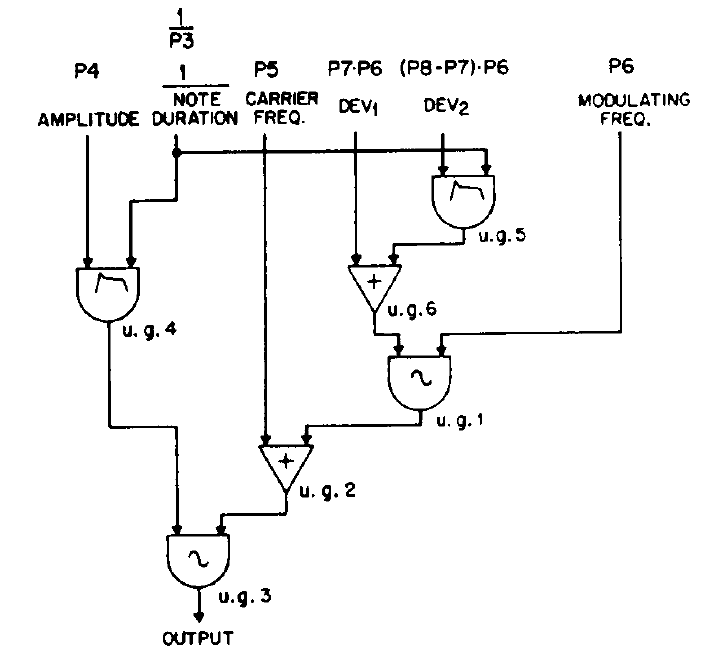FM Synthesis: History & Backgroud
A Brief History
As mentioned in Introduction II, John Chowning brought a copy of the MUSIC IV software from Bell Labs to Stanford, where he founded the CCRMA, and started experiments in sound synthesis. Although frequency modulation was already a method used in analog sound synthesis, it was Chowning who developed the concept of frequency modulation (FM) synthesis with digital means in the late 1960s.
The concept of frequency modulation, already used for transmitting radio signals, was transferred to the audible domain by John Chowning, since he saw the potential to create complex (as in rich) timbres with a few operations (Chowning, 1973).
For one sinusoid modulating the frequency of a second, frequency modulation can be written as:
\[ y(t) = \sin(2 \pi f_c + I_m \sin(2 \pi f_m t) ) \]
\(f_c\) denotes the so called carrier frequency, \(f_m\) the modulation frequency and \(I_m\) the modulation index. [Fig.1] shows a flow chart for this operation in the style of MUSIC IV.

- Fig.1
-
Flow chart for FM with two operators (Chowning, 1973).
In many musical applications, the use of dynamic spectra is desirable. The parameters of the above shown FM algorithm are therefor controlled with temporal envelopes, as shown in [Fig.2]. Especially the change of the modulation index over time is important, since it results in percussive sound qualities. In musical applications, multiple carriers and modulators, referred to as operators, are connected in different configurations, for generating richer timbres.

- Fig.2
-
Flow chart for dynamic FM with two operators (Chowning, 1973).
FM synthesis is considered an abstract algorithm. It does not come with a related analysis approach to generate desired sounds but they need to be programmed or designed. However, there are attempts towards an automatic parametrization of FM synthesizers (Horner, 2003).
John Chowning, composer by profession, combined the novel FM synthesis approach with digital spatialization techniques to create quadraphonic pieces of electronic music on a completely new level. In Turenas, completed in 1972, artificial doppler shifts and direct-to-reverberation techniques are used to intensify the perceived motion and distance of panned sounds in the loudspeaker setup. The sounds used in this piece are only generated by means of FM, resulting in a characteristic quality like the synthetic bell-like sounds beginning at 1:30 or the re-occuring short precussive events.
References
2011
- John Chowning.
Turenas: the realization of a dream.
Proc. of the 17es Journées d’Informatique Musicale, Saint-Etienne, France, 2011.
[details] [BibTeX▼]
2003
- Andrew Horner.
Auto-programmable FM and wavetable synthesizers.
Contemporary Music Review, 22(3):21–29, 2003.
[details] [BibTeX▼]
1973
- John M Chowning.
The synthesis of complex audio spectra by means of frequency modulation.
Journal of the audio engineering society, 21(7):526–534, 1973.
[details] [BibTeX▼]
